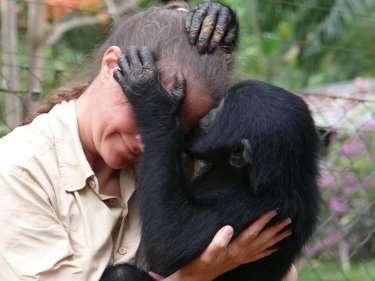Humans not guilty in shaping chimpanzee, bonobo behavior

Human encroachment has not turned chimpanzees and bonobos into warmongers bent on violence and infanticide as many people have theorized. The behavior comes naturally, report 30 international researchers, including University of Oregon anthropologist Frances White, in the Sept. 18 issue of Nature.
Since Jane Goodall first reported on chimpanzee violence in the 1970s, many people have compared their aggression to primitive warfare or theorized that chimpanzees kill because humans have destroyed some of their habitats. In the new report, the observations made over 50 years by researchers in 18 chimpanzee (Pan troglodytes) communities and four bonobo (Pan paniscus) communities were pulled together for the first time.
The aggressiveness that has been seen is a natural adaptation that benefits them within their social organizations, says White, head of the UO Department of Anthropology. The study, led by University of Minnesota researcher Michael L. Wilson, also highlights the differences between chimpanzees and bonobos, says White, whose 30 years of research has determined that bonobos are not chimps.
"Chimps and bonobos are the two living species most closely related to us of all the animals alive today," Wilson said in a U of M news release. "We share the most in common in terms of genetics and evolutionary history. Based on our results, it's clear that lethal aggression is something that chimpanzees naturally do. We found that chimpanzees sometimes kill other chimpanzees, regardless of whether human impacts are high or low, whereas bonobos were not observed to kill, whatever the level of human impacts."
The researchers involved represent long-running study sites of chimpanzees whose habitats are located outside of a circle formed by the Congo River in Africa. The bonobo sites, studied by White, fall within the river's circle and all within the Democratic Republic of the Congo. The habitats of the two species, while virtually identical in size and appearance, do not overlap.

Michel Waller, who earned a doctorate in anthropology from the UO in 2011 while working under White's direction, also was a co-author of the Nature paper.
"What we've contributed to the study is the absence of aggression," said White, who heads the Department of Anthropology and directs the UO's Primate Osteology Laboratory. "One thing this paper shows is that lethal aggression and infanticide that you see in chimpanzees is an adaptive strategy, but the opposite is also true. The peaceful nature of bonobos is an adaptive strategy."
That adaptive strategy, she said, refers to a biological function in which the violent nature of chimpanzees and the mostly peaceful nature of bonobos act in ways that best suits their standing within their very different social structures.
Male-dominated chimpanzees battle for food, females or other power that is important to them, White said. For female-dominated bonobos, she noted, being aggressive doesn't pay off. "They prefer to be peaceful. A lot of the peacemaking among bonobos happens because of sexual behavior."
When White began her research on bonobos in 1983, while a doctoral student at the State University of New York at Stony Brook, they were called pygmy chimpanzees—a misnomer, she said, because bonobos "are neither pygmies or smaller than chimpanzees."
Her observations started as she used compasses and laid tape through the jungles to determine their range. Using global positioning system (GPS) technology, Waller revisited White's manual measurements and merged them with his new data into a Geographic Information System (GIS) system. White's study area covers 36 square kilometers, or 22.4 square miles.
Her UO lab houses a dedicated GIS/GPS computer that allows for statistical analysis by UO and outside researchers. The lab also houses the Primate Osteology Collection, which allows students to study bones and their structures, and a large data-storage system for large biological anthropology datasets and biological anthropology teaching resources.
Waller, now on the anthropology faculty at Central Oregon Community College in Bend, tapped the GIS data to examine the differences in ranging behavior between the apes and how their differences are related to variations in social structure, male and female sexual strategies, and inter-community aggression. Bonobos, White noted, live as long as humans.
More information:
phys.org/news/2014-09-natural- … panzee-violence.html
Provided by University of Oregon